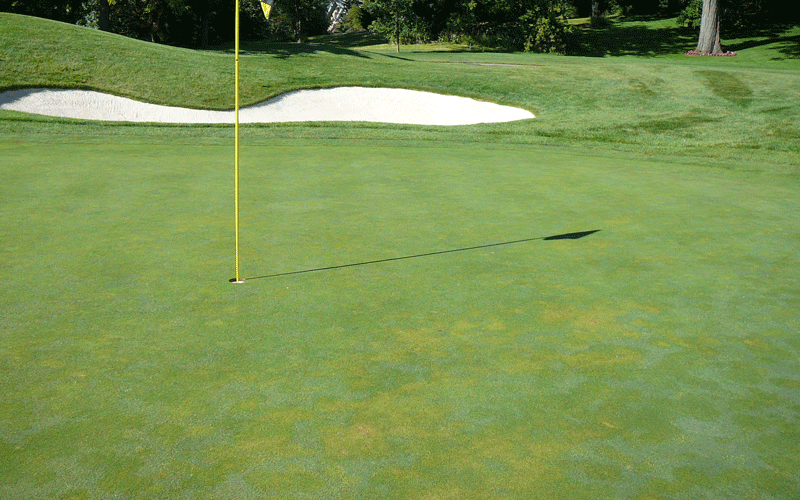Summer Decline of Cool-season Greens
The decline in turf quality on creeping bentgrass and/or annual bluegrass greens is a major problem in the summer months. Biotic stresses like diseases and nematodes along with abiotic stresses like high temperature, excessive moisture, and poor air movement combine forces to cause turf decline, so an integrated management approach is needed.
-
Abiotic cause
- Heat stress is the primary factor contributing to the decline of cool-season grasses during summer months.
- Photosynthesis of cool-season grasses begins to decline at air temperatures above 70oF while respiration increases with increasing temperature
- Once air temperatures exceed about 85oF (soil temperature > 75oF), the rate of energy consumption (respiration) outpaces the rate of energy production (photosynthesis). The plant can tolerate this energy deficit in the short term by using storage carbohydrates
- However, with continued high temperature, storage carbohydrates are depleted. This leads to dramatic dieback in turfgrass roots, which reduces water and nutrient uptake and, ultimately, decreases turf quality and density and increases sensitivity to biotic and abiotic stresses
-
Biotic causes
- Negative effects of all foliar and soilborne pathogens (even minor ones) are magnified when cool-season turf is under abiotic stress
- We now better understand the threat of nematodes in cool-season turf and how they can enhance not only damage from abiotic stress, but also from soilborne diseases
-
Cultural practices to alleviate turf stress during summer:
- Aerify to promote rooting, air exchange, and water infiltration
- Syringe and use fans to lower canopy temperature and increase air movement
- Sand topdressing to protect turfgrass crowns, dilute thatch, and improve edaphic conditions
- Increase mowing height—raising height of cut by as little as 0.030” can increase photosynthetic efficiency by 40% and increase root biomass by 25%
- Use lightweight rolling or increased mowing frequency to offset higher heights of cut and maintain acceptable green speeds
- Spoon feed with water soluble nutrients to encourage growth and recovery
- Tree removal and root pruning to maximize sunlight and limit competition for resources
- Practice judicious irrigation to replace evapotranspiration, and use handheld and buried soil moisture sensors to maximize uniformity and avoid over- or under-watering
-
Fungicide control:
- A preventative program should be initiated in mid-spring to minimize inoculum of most diseases like dollar spot, summer patch, root pythium, etc.
- The preventative program should continue with regular applications prior to onset of summer stress and continued throughout the summer
- Signature® XTRA Stressgard® should be applied every 7-14 days as the cornerstone of a plant health, while also controlling turfgrass diseases
- Additional Stressgard fungicides including Exteris®, Interface®, Tartan® and Mirage®, also provide excellent control of summer diseases while aiding in mitigating abiotic stress
- Stressgard fungicides have been extensively researched for over 25 years and have been found to consistently increase chlorophyll and improve photosynthetic efficiency, which no other fungicide claiming plant health can substantiate. This improved photosynthesis results in increased rooting, stress tolerance, and turf density - all critical to maximize your turf’s performance throughout the summer
- Envu’s Deniscor®, Resilia®, and Castlon® are non-Stressgard products that are highly effective on both foliar and soilborne pests
- Need more info? – Read and follow all label directions. Contact your Envu Area Sales Manager if you need assistance
| Solution sheet - Summer patch | |
| Solution sheet - Pythium root rot |
Summer decline of an annual bluegrass/creeping bentgrass green (Envu).

